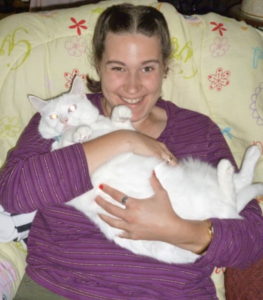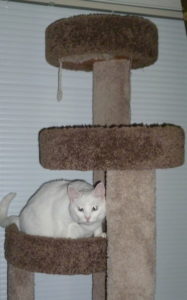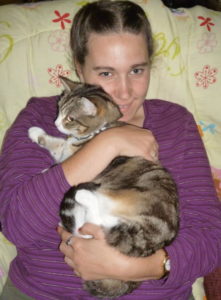“I wanted one calico cat.” Lindsey picked up Cuddles and showed me one of the two adorable, healthy kittens she adopted five years ago. (Cute and healthy were her two requirements.) Lindsey set Cuddles down on the carpet. She tossed the red ball that Cuddles likes to chase. The cat ran after it, pawing at the toy. Lindsey giggled. “She’s so cute!”
Before selecting a kitten, Lindsey searched all the adoptable cats and kittens in every single room of Friends Of Felines in Salem. We picked this organization because they operate a no-kill rescue program and believe that every life matters.

Still, Lindsey was particular. She wanted to pick the perfect kitten. For her. An hour later, just as my daughter made her selection, the volunteer told Lindsey that a tiny white kitten was the calico’s sister. Lindsey’s blue eyes widened; she tilted her head. “I didn’t want to separate the two of them. You don’t separate sisters. So I ‘dopted them both.”
I wasn’t sure Lindsey could handle two cats. Friends of Felines require adoptees to remain inside at all times. I wondered, would an apartment complex allow my daughter to keep two? And two cats would require twice the amount of food, litter, and vet bills. My girl lived on an extremely limited income. I didn’t want pet ownership to strain her tight budget. But Lindsey eagerly signed the contract and took two kittens home with her.
“I named the white one Sally because I used to have a goldfish named Sally and I liked that name.” Lindsey cornered the white cat and pulled her close to her chest. “Uncle Bob said I should name this one Snowflake, but he doesn’t come up with good cat names. But I still love my Uncle Bob.” Lindsey set Sally down and the cat ran into the bedroom and hid under the bed.
 “Sally is shy,” Lindsey confessed. “Cuddles has pretty colors.” She said that the two cats love to play with each other and climb the cat tree her cousin Todd gave her. “That was really nice of him.” Lindsey smiled wide. “They use it all the time.”
“Sally is shy,” Lindsey confessed. “Cuddles has pretty colors.” She said that the two cats love to play with each other and climb the cat tree her cousin Todd gave her. “That was really nice of him.” Lindsey smiled wide. “They use it all the time.”
“My cats are very talented,” Lindsey told me, using her hands to explain how they climb on the cat tree and hide in it, climb to the top, and hang over the edge. “Sally does flips,” Lindsey said. She used to worry that the cats would get hurt with all the running and jumping, “but they never do.” Lindsey’s hands went wild when she demonstrated how the cats play-fight and run around the house like crazy.
“When they fight, I tell them, ‘one day your sister is going to be gone and it won’t be fun. So quit fighting.’”
Initially, Lindsey adopted the cats as pets. And she has taken great care of them. They’ve never gone without food or their annual visit to the vet. But over the years, these two felines have become more than that. They’ve become emotional support animals (ESA). An ESA is one whose sole function is to provide emotional support, comfort, therapy, companionship, therapeutic benefits, or promote emotional wellbeing.

“When I feel down, I just need to hold one of my cats and I feel lots better. They’re like my babies. They sleep with me. They keep me from being lonely, scared, and nervous.”
Having an animal to care for helps reduce my daughter’s anxiety. When Nick was super sick, the cats were around to keep her company. Besides going to work, they are a couple of the reasons she gets out of bed every morning.
Because Sally and Cuddles are emotional support animals, Lindsey has certain rights when obtaining housing in the State of Oregon. There are three kinds of animals identified as helping individuals: (1) Service animals – highly trained (2) Emotional support animal (ESA), or (3) Therapy animals (which may not qualify to live in a “no pets” house.)”
According to the Fair Housing Council of Oregon, it states:
It doesn’t matter what you call them (service animal, assistance animal, therapy animal, companion animal, aide animal, working animal, etc.
They are not pets and may not be treated as such (denied because “pets” aren’t allowed, charged a fee/deposit/or rent specific to that assistance animal, etc.)
Such animals are defined differently under fair housing laws than in the Americans with Disabilities Act. The Fair Housing Act applies in all housing transactions (renting, sales, homeowners associations, etc.).
Generally, you may not restrict the breeds of assistance animals but in very narrow circumstances
In order for a tenant to qualify for this waiver, the tenant may be required to provide a note from a physician verifying the companion (ESA) or therapy animal is needed, i.e. as an accommodation to the person with the disability. The animal does not necessarily need to be a certified service or companion animal. After moving in, if requested, tenants may be required to provide a letter from a medical professional. The letter should include these two things:
Tenant has a disability (the medical professional doesn’t need to state the kind of disability)
That the animal is necessary to treat the disability that Tenant possesses (no certification or specification of what the animal does to treat the disability is necessary)
“This is good news,” Lindsey told me, a grin plastered across her face. “No matter where I go in the world, my cats can go with me.”
Since Lindsey hates to travel, I doubt she’ll go far. But she’s right. This is good news.

My first book will be coming out September 26, 2017. If you are interested in learning more about Loving Lindsey: Raising a Daughter with Special Needs, please click here.

